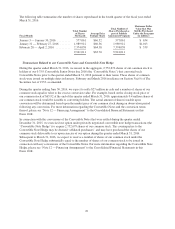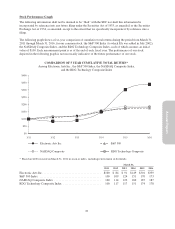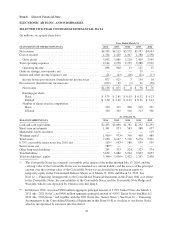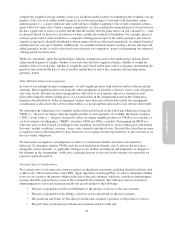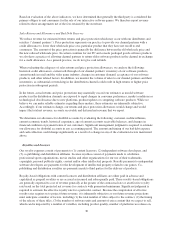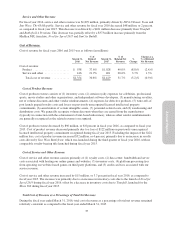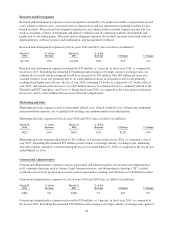Electronic Arts 2016 Annual Report Download - page 116
Download and view the complete annual report
Please find page 116 of the 2016 Electronic Arts annual report below. You can navigate through the pages in the report by either clicking on the pages listed below, or by using the keyword search tool below to find specific information within the annual report.Based on evaluation of the above indicators, we have determined that generally the third party is considered the
primary obligor to end consumers for the sale of our interactive software games. We therefore report revenue
related to these arrangements net of the fees retained by the storefront.
Sales Returns and Allowances and Bad Debt Reserves
We reduce revenue for estimated future returns and price protection which may occur with our distributors and
retailers (“channel partners”). Price protection represents our practice to provide our channel partners with a
credit allowance to lower their wholesale price on a particular product that they have not resold to end
consumers. The amount of the price protection is generally the difference between the old wholesale price and
the new reduced wholesale price. In certain countries for our PC and console packaged goods software products,
we also have a practice of allowing channel partners to return older software products in the channel in exchange
for a credit allowance. As a general practice, we do not give cash refunds.
When evaluating the adequacy of sales returns and price protection allowances, we analyze the following:
historical credit allowances, current sell-through of our channel partners’ inventory of our software products,
current trends in retail and the video game industry, changes in customer demand, acceptance of our software
products, and other related factors. In addition, we monitor the volume of sales to our channel partners and their
inventories, as substantial overstocking in the distribution channel could result in high returns or higher price
protection in subsequent periods.
In the future, actual returns and price protections may materially exceed our estimates as unsold software
products in the distribution channels are exposed to rapid changes in consumer preferences, market conditions or
technological obsolescence due to new platforms, product updates or competing software products. While we
believe we can make reliable estimates regarding these matters, these estimates are inherently subjective.
Accordingly, if our estimates change, our returns and price protection allowances would change and would
impact the total net revenue, accounts receivable and deferred net revenue that we report.
We determine our allowance for doubtful accounts by evaluating the following: customer creditworthiness,
current economic trends, historical experience, age of current accounts receivable balances, and changes in
financial condition or payment terms of our customers. Significant management judgment is required to estimate
our allowance for doubtful accounts in any accounting period. The amount and timing of our bad debt expense
and cash collection could change significantly as a result of a change in any of the evaluation factors mentioned
above.
Royalties and Licenses
Our royalty expenses consist of payments to (1) content licensors, (2) independent software developers, and
(3) co-publishing and distribution affiliates. License royalties consist of payments made to celebrities,
professional sports organizations, movie studios and other organizations for our use of their trademarks,
copyrights, personal publicity rights, content and/or other intellectual property. Royalty payments to independent
software developers are payments for the development of intellectual property related to our games. Co-
publishing and distribution royalties are payments made to third parties for the delivery of products.
Royalty-based obligations with content licensors and distribution affiliates are either paid in advance and
capitalized as prepaid royalties or are accrued as incurred and subsequently paid. These royalty-based obligations
are generally expensed to cost of revenue generally at the greater of the contractual rate or an effective royalty
rate based on the total projected net revenue for contracts with guaranteed minimums. Significant judgment is
required to estimate the effective royalty rate for a particular contract. Because the computation of effective
royalty rates requires us to project future revenue, it is inherently subjective as our future revenue projections
must anticipate a number of factors, including (1) the total number of titles subject to the contract, (2) the timing
of the release of these titles, (3) the number of software units and amount of extra content that we expect to sell,
which can be impacted by a number of variables, including product quality, number of platforms we release on,
30




